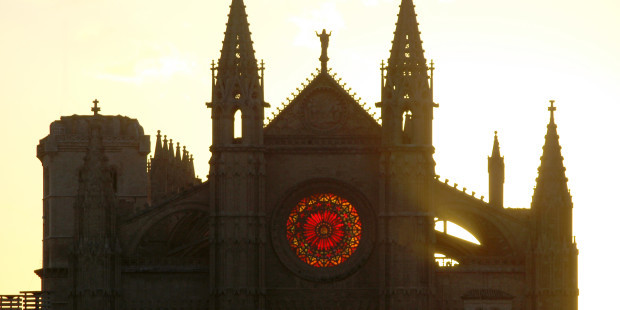Each year, the Cathedral of Majorca (in the city of Palma, on the Spanish Mediterranean island of Majorca) exhibits two tricks of light, the centers of which are its largest rose window and its main facade. The first phenomenon is known as the Spectacle of the 8, and it takes place on February 2 (the Feast of the Presentation) and on November 11 (Feast of Saint Martin), when the light of the morning sun shines through the largest rose window and falls on the inside wall right below the rose window in the main facade, forming the number 8.
The other lightshow takes place between December 20 and 23, on the winter solstice, and it can only be seen from outside; the morning light coming through the main rose window shines directly on the opposite rose window in the facade, creating a magnificent combination of colors.
The Cathedral of Majorca is an edifice of great size, with a total height of approximately 48 yards at the central nave, and a length of 132 yards.
Cristina Ortiz, coordinator of educational visits to the cathedral, says that “these measurements make it the Gothic cathedral with the greatest usable space with the least amount of stone. Consequently, you have a spacious and ample view of the interior, with its tall and slender columns.” This sensation of wide open space is also due to the illumination, with more than 60 stained glass windows and five rose windows that allow the Mediterranean sun to fill the interior of the building.
“The Eye of the Gothic”
Of the five rose windows, the largest is one of the most famous in the world, as it is the largest rose window in all of Gothic architecture; this has earned it the sobriquet “Eye of the Gothic.” It is nearly 40 feet in diameter, and was built in 1370, although the glass was added later. It stands out especially for the star of David formed by 24 triangles, and for its unusual location above the sanctuary, and not in the facade, as was the custom.
Retaking the island from the Muslims
According to legend, when King James I the Conquerer was heading towards Majorca in 1229 to reconquer the island, which had been occupied by Muslims, he and his expedition were at the point of shipwreck due to a mighty storm. Right then, the king promised the Virgin Mary that he would build a church and dedicate it to her if his enterprise succeeded. The storm was calmed, and the king and his troops were able to reach the island, disembarking at Santa Ponsa Bay.
James I then decided to fulfill his promise, and the Cathedral of Majorca is the result. However, the king limited himself at that time to initiating the conversion of the old mosque of Madina Mayurqa into a Christian house of worship.
Immediately after reconquering the island, the main mosque, located within the confines of the Almudaina Palace, was consecrated so that it could be dedicated to Christian worship while preparations began for the construction of an entirely new building.
It was the king’s son, James II (1276-1311), the first king of Majorca, who began the construction at the beginning of the 16th century, starting with the Chapel of the Holy Trinity, the location he chose to be the burial place of the Majorcan dynasty he founded.

